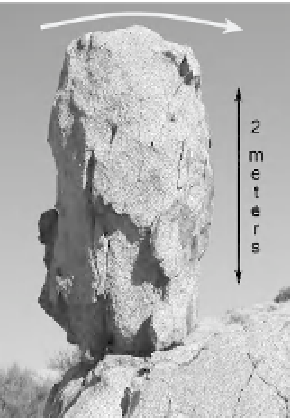Geology Reference
In-Depth Information
can weather to produce fields of perched
boulders. Initially, the bedrock weathers
along the joint surfaces. Erosional removal
of the disaggregated debris creates core
stones that rest and sometimes balance on
underlying bedrock. When such boulders
have a long vertical dimension, they appear
to be precariously perched and should be
highly susceptible to shaking (Brune, 1996).
In fact, some studies show that, if such boul-
ders are less than 0.3 m high, they tend to be
blown over by strong desert winds (Shi
et al.
, 1996). Boulders larger than this
appear to require seismic accelerations to
topple them.
Field tests and modeling of the forces
required to topple the boulders indicate that
accelerations of greater than 0.2
g
would
knock over the more precarious boulders,
whereas accelerations of 0.3
g
-0.4
g
would be
required for the “semi-precarious” boulders
(Brune, 2002). Such numbers provide very
useful paleoseismological limits on the magni-
tude of past shaking. If these boulders are still
standing, then they have not been subjected
to sufficiently strong ground motions to knock
them down since the time they became pre-
cariously perched. A key to the analysis thus
becomes the determination of the time when
the boulders became susceptible to shaking
and toppling. Presumably, a precarious state
was achieved when the boulder was signifi-
cantly undercut to create a “pedestal” at its
base. Radiocarbon dating of the desert varnish
around boulder pedestals has provided time
control in several areas of the southwest
United States. Surprisingly, these data (Brune
et al.
, 2006) suggest that the amount of ground
shaking during the past 10-30 kyr in the areas
of perched boulders has been much less
than that predicted by the Working Group on
California Earthquake Probabilities (1995),
which has tried to assemble all of the relevant
seismic, geodetic, and paleoseismological data
into quantitative models of earthquake haz-
ards. Not all areas have perched boulders, but
where they are present (or where they have
been toppled over), they represent a useful
paleoseismic tool.
seismic
shaking
Precariously balanced boulders act as a
paleo-accelerometer.
But how do we date the time of addition of
individual blocks? One recently developed
method relies on the concept that lichens
colonize freshly exposed, stable rock surfaces
and that, after an initial period of more rapid
growth, lichens grow at a steady and predictable
rate (Bull
et al.
, 1994; Locke
et al.
, 1979) (see
Chapter 3). A lichen growth curve can be devel-
oped based on maximum lichen sizes of a par-
ticular species found on rock surfaces that were
exposed in a known year. Such surfaces can
include both geomorphic features and cultural
ones, such as walls, buildings, or gravestones.
Careful choice of the rockfall site combined
with knowledge of historical earthquakes can
help establish growth rates, if not previously
known. For example, on rather stable slopes,
only intense shaking due to rupture on a nearby
fault is likely to dislodge boulders (Box 6.2).
Commonly rockfall deposits in such sites may
only include blocks that were added during
earthquakes on that fault. Peaks in histograms



































